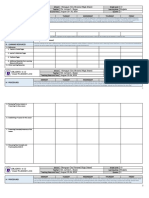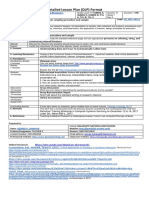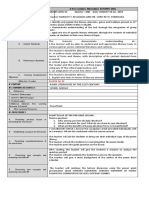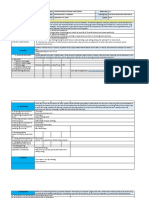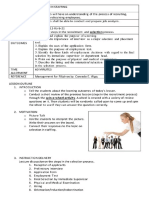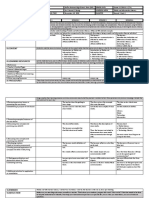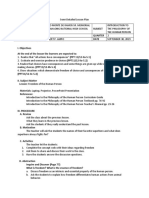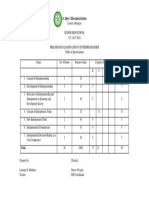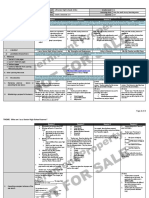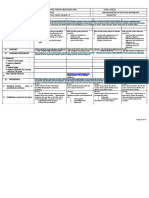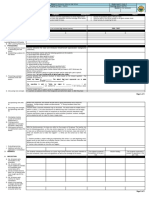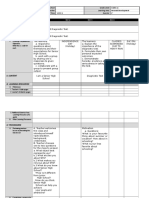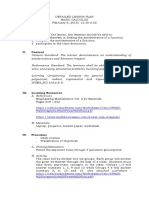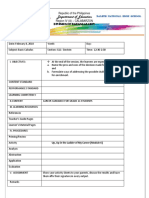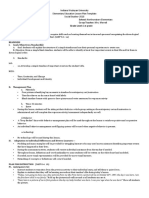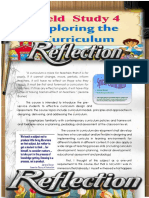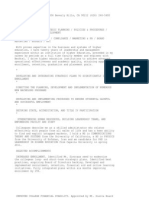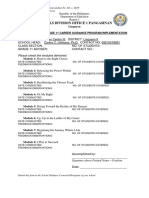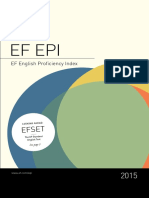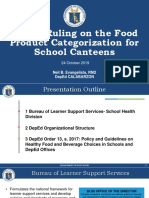THEME: Who am I as a Senior High School learner?
School
Teacher
Teaching Dates and Time
GRADES 1 to 12
DAILY LESSON LOG
All Senior High Schools (SHSs)
Grade Level
Learning Area
Quarter
Week 1 Sessions 1-4
11
May be used in any learning area
1st
dsd
Session 1
I.
Session 2
Session 3
Session 4
Objectives must be met over the week and connected to the curriculum standards. To meet the objectives, necessary procedures must be followed and if needed, additional lessons,
exercises and remedial activities may be done for developing content knowledge and competencies. These are assessed using Formative Assessment strategies. Valuing objectives support
the learning of content and competencies and enable children to find significance a n d j o y inlearning the lessons. Weekly objectives shall be derived from the curriculum guides.
OBJECTIVES
A. Content Standards
B. Performance Standards
At the end of the session, learners are expected to:
1.
respond to questions about themselves and
their expectations for Senior High School
2.
work with a group by sharing ones responses
to given questions;
3.
collaborate with a group to present group
output.
C. Learning Competencies / Objectives
Write the LC code for each
At the end of the session, learners are
expected to:
1.
identify ones strengths and
weaknesses; and
2.
illustrate/show responses through
various creative means.
At the end of the session, learners are expected
to:
1.
present creative output based on ones
strengths and weaknesses; and
2.
appreciate that class members have
strengths and weaknesses.
At the end of the session, learners are
expected to:
1.
express how they feel about their
subjects and teachers;
2.
brainstorm how their class can be
happy given their similarities and
differences; and
3.
contribute to class rules,
regulations, norms, and
agreements.
II.
CONTENT
Content is what the lesson is all about. It pertains to the subject matter that the teacher aims to teach. In the CG, the content can be tackled in a week or two.
III.
LEARNING RESOURCES
List the materials to be used in different days. Varied sources of materials sustain childrens interest in the lesson and in learning. Ensure that there is a mix of concrete and manipulative
materials as well as paper-based materials. Hands-on learning promotes concept development.
I am a Senior High School Learner
My Strengths and Weaknesses
Unity in Diversity
Me, My Teacher and My Class
A. References
1. Teachers Guide pages
2. Learners Materials pages
3. Textbook pages
4. Additional Materials from Learning
Resource (LR) portal
http://www.tecweb.org/styles/gardner.html
Howard Gaardners Theory of Multiple
Intelligences
B. Other Learning Resources
IV.
A.
B.
These steps should be done across the week. Spread out the activities appropriately so that students will learn well. Always be guided by demonstration of learning by the students which
you can infer from formative assessment activities. Sustain learning systematically by providing students with multiple ways to learn new things, practice their learning, question their learning
processes, and draw conclusions about what they learned in relation to their life experiences and previous knowledge. Indicate the time allotment for each step.
PROCEDURES
Reviewing previous
lesson
presenting the new lesson
or
Establishing a purpose for the lesson
(2 mins)
Teacher welcomes the class and introduces
himself/herself (specialization, background,
credentials).
(5 mins)
1.
From the list below, teacher chooses one to two
questions for the class to answer. Subject teachers
coordinate with each other so that there will be
no/minimal duplication of questions used in class.
a. What object best represents you?
b. What excites you about SHS?
(5 mins)
Teacher reviews the questions asked and
class responses from Session 1.
( 10 mins)
1.
Teacher presents the different
Intelligences and gives a brief explanantion for
each:
a.
Verbal-Linguistic
b.
Logical-Mathematical
c.
Interpersonal
(5 mins)
Teacher reviews activities from the last
session. Teacher explains that this session
will be for presentation of output.
(50 mins)
Below are options that classes may use for
presenting class output:
1.
Gallery walk
2.
Individual/group presentations
Presentations may vary per subject.
(5 mins)
Class reviews presentations from the last
session. Class discusses what they have
learned from the presentations.
(25 mins)
1.
Teacher says: I had the chance to
know each one of you in the past days.
Now, I want to know your expectation from
me since we will be together in this
semester.
Page 1 of 4
�THEME: Who am I as a Senior High School learner?
c.
d.
e.
f.
g.
h.
2.
Session 1
What makes you nervous about SHS?
What age will you be 10 years from now?
i. How would you like to look like?
ii. What would you like to be doing?
iii. Where would you like to be
working?
What do you know about Senior High
School?
i. How is it different from Junior High
School?
ii. How do you think Senior High
School can help you achieve your
goals and ambitions?
What are your top three positive personal
qualities/traits?
What are two not-so-positive
characteristics that you have?
What are three correct, good, or wise
choices that you made in JHS? What
were the effects of these actions?
Teacher asks learners to bring out a piece of
paper and be ready with a pen or pencil.
3.
Teacher says : Lets get to know a little bit
about each other today.
Teacher provides the sentence structure to follow
based on the chosen question. For example, for
question a:
Hello, my name is ___________. The object that best
represents me is a/an ________________ because
______________________.
C.
D.
Presenting examples/ instances of the
new lesson
For questions b and c:
Hello, my name is _________________. I am
from_______________. I am excited for
___________________. I am nervous about
___________________.
Teacher models how to respond using the suggested
sentence structure.
(30 mins)
1. Learners are asked to think of their responses
and write them down.
Discussing new concepts and practicing 2. After they have written their responses, the
new skills #1
teacher will ask them to group themselves into
at most five members. Groups assign a leader
and documenter.
3. Group members share their responses.
d.
e.
f.
g.
h.
i.
Session 2
Intrapersonal
Visual-Spatial
Bodily-Kinesthetic
Musical-Rhythmic-Harmonic
Naturalistic
Existential
2.
Teacher says: Based on what you feel
are your top two intelligence/s, think of how
you can illustrate/show your response to the
question yesterday. Learners may choose
from the following options. They may choose
more than one.
a.
An object to represent yourself
b.
Collage
c.
Drawing
d.
Song/Rap
e.
Dance/Movement
f.
Poem/Acrostic
g.
Script/Story
h.
Comic Strip
Session 3
For example, those that have prepared
dance/song presentations may present during
their Humanities subjects.
Teachers will coordinate accordingly so that
each learner has a chance to present for the
day.
Session 4
2.
Learners bring out a of sheet of
paper and ballpen.
3.
Teacher says: I need you to
complete the following sentences.
a.
I like (name of subject)
because __________________.
b.
I dont like (name of subject)
because _____________.
c.
I like it when the teacher
____________________.
d.
I dont like it when the teacher
________________.
4.
Teacher collects the sheets of
paper, reads the answers, and reflects
with the class.
(40 mins)
3.
Learners are given time to prepare and
work on their output.
(15 mins)
1. Teacher draws a semantic web/word
map on the board. The word inside
the middle circle is HAPPY CLASS.
2. The class brainstorms for different
ways that a classroom can be happy
and interesting.
3. Teacher writes the responses on the
board (semantic web/word map).
(15 mins)
Teacher and learners make an agreement
on which activities, practices, routines,
strategies will be adopted by both to make
the class a happy class.
Page 2 of 4
�THEME: Who am I as a Senior High School learner?
4.
E.
Session 1
Groups then share their responses to the class.
Session 2
Session 3
Session 4
Discussing new concepts and practicing new
skills #2
F. Developing mastery
(Leads to Formative Assessment 3)
G. Finding practical applications of concepts
and skills in daily living
H. Making generalizations and abstractions
about the lesson
I. Evaluating learning
J. Additional activities for application or
remediation
(15 minutes)
After the sharing session, the class can reflect on the
answers of the group. The teacher can ask the
following questions:
a.
Who has similar responses?
b.
In what ways are they similar?
c.
How can our differences bring about
positive effect/s for the learners, class and
school?
d.
What can students do to make sure
Senior High School be a positive
experience?
e.
What can teachers do to make this
happen?
f.
What can the school do to make this
happen?
(8 mins)
1. Teacher provides a proper ending by
emphasizing that SHS is a new beginning and a
proper venue to start anew as an individual,
learner, and as a class, that their similarities and
differences will help the class achieve their goals.
2. Teacher can cite examples on how this can
happen.
(5 mins)
Teacher closes the session by how people will
have different strengths and weaknesses.
Teacher asks learners to pack away.
(5 mins)
Teacher summarizes how a class is made up
of learners with different strengths and
weaknesses. Teacher then emphasizes that
there can be unity despite diversity.
Teacher and students write the agreement
on a cartolina/manila paper and should be
posted inside the classroom for everyone
to see during the semester.
Each subject may contribute to the
agreements. These should be collated for
each class.
Agreement: Bring old or used magazines,
newspapers, catalogues, brochures, leaflets, etc; art
materials, i.e. scissors, glue, crayons, color pencils,
markers, bond paper, etc.
V. REMARKS
VI. REFLECTION
Reflect on your teaching and assess yourself as a teacher. Think about your students progress this week. What works? What else needs to be done to help the students learn?
Identify what help your instructional supervisors can provide for you so when you meet them, you can ask them relevant questions.
A. No.of learners who earned 80% on the formative
assessment
B. No.of learners who require additional activities for
remediation.
C. Did the remedial lessons work? No.of learners
who have caught up with the lesson.
D. No.of learners who continue to require
Page 3 of 4
�THEME: Who am I as a Senior High School learner?
Session 1
Session 2
remediation
E. Which of my teaching strategiesworked
well?Why did these work?
F. What difficulties did I encounter which my
principal or supervisor can help me solve?
G. What innovation or localized materials did I
use/discover which I wish to share with other
teachers?
For improvement, enhancement and/or clarification of any DepEd material used, kindly submit feedback to bld.tld@deped.gov.ph
Session 3
Session 4
Page 4 of 4
�THEME: What study skills do I need to succeed in Senior High School (SHS)?
School
Teacher
GRADES 1 to 12
DAILY LESSON LOG
Teaching Dates and Time
All Senior High Schools (SHSs)
Grade Level
Learning Area
Week 2 Sessions 1-4 (with optional Session 5)
Quarter
11
May be used in any learning area
1st
Ds
Session 1
I.
OBJECTIVES
1.
A. Content Standards
2.
3.
1.
B. Performance Standards
2.
1.
C. Learning Competencies /
Objectives
Write the LC code for each
Session 2
Session 3
Session 4
Session 5 (optional)
Objectives must be met over the week and connected to the curriculum standards. To meet the objectives, necessary procedures must be followed and if needed, additional lessons, exercises and
remedial activities may be done for developing content knowledge and competencies. These are assessed using Formative Assessment strategies. Valuing objectives support the learning of content and
competencies and enable children to find significance a n d j o y inlearning the lessons. Weekly objectives shall be derived from the curriculum guides.
2.
3.
The learner understands the
importance of developing study or
academic skills tosucceed in Senior
High School (SHS)
The learner demonstrates
understanding of different note-taking
methods
The learner understands the
importance of time-management in
studying
The learner applies note-taking
methods
The learner produces a sample
weekly study schedule
Identify the steps of the Cornell Notetaking Method
Identify the Five (5) Rs of Note Taking
Create a weekly study schedule
1.
2.
The learner demonstrates
understanding of critical
reading strategies
The learner recognizes the
importance of critical
reading in academic
success
1.
2.
The learner demonstrates
understanding of critical
reading strategies
The learner recognizes the
importance of critical
reading in academic
success
The learner applies critical
reading strategies
The learner applies critical
reading strategies using SQ3R
1.
2.
1.
Define critical reading
Identify and describe
different critical reading
strategies
2.
Identify the different parts of
the SQ3R
Read a selectiong using
SQ3R
1.
2.
3.
The learner understands
the importance of academic
integrity and intellectual
honesty
The learner demonstrates
respect for another
individuals work in
academic writing
The learner applies academic
writing skills using strategies
such as quoting, summarizing,
and paraphrasing
1. Distinguish between
original work and
plagiarized text
2. Quote, paraphrase, and/or
summarize an original text
1.
2.
The learner understands
the importance of preparing
for a test
The learner demonstrates
understanding of different
strategies to improve
memory
The learner applies memory
strategies using acrostics and
acronyms
Create acrostics and acronyms
for frequently used formulae,
terminologies, and concepts
Content is what the lesson is all about. It pertains to the subject matter that the teacher aims to teach. In the CG, the content can be tackled in a week or two.
II.
CONTENT
III.
LEARNING
RESOURCES
Study Skills: Overview of Study Skills
Note taking and time management
Study Skills: Critical Reading
Study Skills: Critical Reading
Study Skills: Avoiding Plagiarism
in Academic Writing
Study Skills: Improving Memory
and Test-taking Skills
1.https://www.stephencovey.com/7habits/7h
abits.php
2.http://www.studyskills.soton.ac.uk/studytip
s/why_here.htm
3.https://www.bcps.org/offices/lis/researchc
1.http://www.criticalreading.com/c
ritical_reading.htm
2.http://www.uefap.com/reading/r
eadfram.htm
3.http://writing.colostate.edu/guid
1.http://www.criticalreading.com/
critical_reading.htm
2.http://www.uefap.com/reading/r
eadfram.htm
3.http://writing.colostate.edu/guid
1.http://www.blinn.edu/brazos/pa
rallelstud/development/Annotatio
nsummary.pdf
2.http://writing.wisc.edu/Handboo
k/QPA_paraphrase2.html
1.http://www.coedu.usf.edu/zalaq
uett/Help_Screens/study_skillsM
HS.htm
2.http://www.jmu.edu/valleyschol
ars/files/improvemyhighschoolstu
A. References
1. TeachersGuide pages
2. Learners Materials pages
3. Textbook pages
4. Additional Materials from
Learning Resource (LR)
portal
B. Other Learning Resources
Page 1 of 5
�THEME: What study skills do I need to succeed in Senior High School (SHS)?
Session 1
IV.
A.
Session 2
Session 3
Session 4
Session 5 (optional)
ourse/images/Lesson%20Plan%20for%20N
ote%20Taking1.pdf
4.http://www.cls.utk.edu/pdf/ls/Week2_Less
on14.pdf
5.https://www2.usgs.gov/humancapital/docu
ments/TimeManagementGrid.pdf
6.http://successcenter.tamu.edu/getattachm
ent/Student-Resources/Handouts/LectureNote-Taking.pdf.aspx
7.http://www.admin.cam.ac.uk/univ/plagiaris
m/students/skills/notes.html
8.http://www.educationcorner.com/cornellnote-taking-system.html
9.http://www.educationcorner.com/habitsof-successful-students.html
es/guide.cfm?guideid=31
4.https://www.csuohio.edu/writing
-center/critical-reading-whatcritical-reading-and-why-do-ineed-do-it
5.http://www.skillsyouneed.com/le
arn/critical-reading.html
6.http://www.educationcorner.co
m/sq3r-textbook-strategy.html
es/guide.cfm?guideid=31
4.https://www.csuohio.edu/writin
g-center/critical-reading-whatcritical-reading-and-why-do-ineed-do-it
5.http://www.skillsyouneed.com/l
earn/critical-reading.html
6.http://www.educationcorner.co
m/sq3r-textbook-strategy.html
3.http://writing.wisc.edu/Handboo
k/AnnBib_content.html
4.https://www.mesacc.edu/~paoi
h30491/ArgumentsQuoteSumma
rizeParaphr.html
3.http://www.indiana.edu/~wts/pa
mphlets/plagiarism.pdf
4.https://www.princeton.edu/pr/p
ub/integrity/pages/plagiarism/
5.https://www.indiana.edu/~istd/e
xamples.html
6.http://www.ucalgary.ca/pubs/ca
lendar/current/k-1.html
7.https://www.indiana.edu/~plag/
practice.html
8.http://www.stevendkrause.com/
tprw/Chapter%203.pdf
dyskills.pdf
3.http://www.educationcorner.co
m/test-anxiety.html
4.http://www.lynchburg.edu/acad
emics/tutoring-academicsupport/top-10-study-skills/
Present the Seven (7) Habits of Highly
Effective People by Stephen Covey. (5
minutes)
Say/Ask: Yesterday, we learned
how to organize our tasks and
notes. Do you think that we can
also organize the way we read?
Do you have a specific way or
strategy in reading a text? If yes,
what strategies do you use? (4
minutes)
Say/Ask: Yesterday, we learned
about different ways to read
more critically. What were the 6
strategies we discussed
yesterday? (5 minutes)
1. Present a quote with proper
citation. Ask the learners to
memorize the quote.
Remove the quote posted,
and ask the learners to
recite the quote.
2. Ask: Who among you had
difficulty in remembering the
quote word for word? (2
minutes)
1. After a brief discussion of the 7 Habits,
return to Habit 2: Begin with the end in
mind.
2. Ask: What does this statetement mean?
Why do you think are you in Senior High
School (SHS)? What will you do after
SHS? (5 minutes)
1. Before discussion, remind the class to
take down notes.
2. Discuss study or academic skills.
3. Provide a definition and examples of
Say: Today, we will learn how to
improve our understanding of a
reading material through critical
reading. Take down notes using
the CNTM. (1 minute)
Say: Today we will learn about
another reading strategy that
some of you may be familiar
with already: SQ3R. What do
you think these letters stand
for? (5 minutes)
1. Discuss critical reading.
2. Provide a definition of critical
reading and the ways to do
critical reading.
3. Discuss the ways to read more
1. Introduce and discuss the
SQ3R strategy.
2. Discuss the different
elements of SQ3R: Survey,
1. Present two very brief texts
(original text and plagiarized
text)
2. Say: Can you read the texts
using SQ3R?
3. Wait for the learners to
realize that there is
something wrong. Once a
learner points out the
similarity, cut the activity. Use
prompts (i.e., Do you notice
something wrong with the two
texts?) if the activity goes
beyond 5 minutes. (5
minutes)
Ask: What is intellectual honesty?
Why is it important to
acknowledge the work of other
individuals in your work? In what
ways can we ensure intellectual
honesty in our written work? (5
minutes)
1. Say/Ask: When we use
someone elses work without
giving proper credit, we commit
plagiarism. How can we avoid
PROCEDURES
Reviewing previous lesson
or presenting the new
lesson
B.
Establishing a purpose for
the lesson
C.
Presenting examples/
instances of the new
lesson
Ask: In what ways do you
prepare for a test? Do you use
materials other than your notes
and textbooks? What do you
think can help you study and
improve your memory for a test?
(2 minutes)
Discuss the following strategies
to study for a test: the use of
acronyms, acrostics, narratives,
rhymes, imagery, visualization,
Page 2 of 5
�THEME: What study skills do I need to succeed in Senior High School (SHS)?
Session 1
study or academic skills.
4. Talk about why they are important to
develop.
5. End the discussion by asking a number
of students to summarize what they
learned based on their notes. (10
minutes)
D.
Discussing new concepts
and practicing new skills #1
E.
Discussing new concepts and
practicing new skills #2
1. Ask: How did you take down notes
during our discussion? Did you take
down everything that was said? How did
you decide which ones to take note of?
2. Introduce the Cornell Note-taking
Method (CNTM) as one way of note
taking. Present and discuss the CNTM
template to the class.
3. After discussion, ask learners to transfer
their notes using the CNTM
template.Select students to present their
work.
4. Discuss the Five Rs in note taking:
Record, Reduce, Recite, Reflect,
Review.
5. Discuss other techniques in note-taking
such as using mind maps, tabular notes,
flow charts, index cards, and highlighting
and annotating. Emphasize that there
are different ways to take down notes
and learners should find out which
technique works best for each of them.
(15 minutes)
1. Present the 10 Habits of Highly
Effective Students.
2. Ask: Write a list of things that you need
to do for the week.
3. Ask: Which among these things will you
do first? How will you prioritze each
item on your list? Ask the class what the
following statement by Benjamin
Franklin means to them: "By failing to
prepare, you are preparing to fail."
4. Show the class Coveys Time
Management Grid, and coach learners
on how to prioritize their tasks based on
importance and urgency. Ask the class
to categorize their activities using
Coveys Time Management Grid.
Session 2
critically: Previewing,
Annotating, Summarizing,
Analyzing, Re-reading, and
Responding. (30 minutes)
Session 3
Question, Read, Recall, and
Review.(15 minutes)
Session 4
committing plagiarism?
2. Introduce and provide
defintions for: quotations,
paraphrases, and summaries
3. Provide and discuss examples
for each
(20 minutes)
Session 5 (optional)
and flash cards. (20 minutes)
Discuss test-taking tips.(10
minutes)
Page 3 of 5
�THEME: What study skills do I need to succeed in Senior High School (SHS)?
Session 1
F. Developing mastery
(Leads to Formative Assessment 3)
5. Ask: Why is it important to organize
ones tasks?
(10 minutes)
1. Say/Ask: Identify different note-taking
methods.
2. Describe the CNTM.
3. What are the Five Rs in note-taking?
(5 minutes)
G. Finding practical applications
of concepts and skills in daily
living
1. Ask: Apart from attending classes, in
which other activities can note taking be
a useful skill?
2. Outside school, in what ways can you
apply time management?
(2 minutes)
H. Making generalizations and
abstractions about the lesson
Ask: In your opinion, what are the
characteristics of highly effective students.
(3 minutes)
I. Evaluating learning
1. Read a short passage to the class and
ask them to take notes using the
CNTM.
2. Ask the class to prepare a study
schedule for the week based on their
class schedule. The study schedule
should indicate at which times of the
day they will study and prepare for their
daily classes.
(5 minutes)
Session 2
Session 3
1. Distribute a text to the class.
The text can be any opinion
piece such as an edtorial.
2. Ask the class to apply the
following critical reading
strategies: Previewing,
Annotating, Summarizing,
Analyzing, Re-reading, and
Responding.
(15 minutes)
Ask: Apart from reading in school
in which other activities can critical
reading be a useful skill? (5
minutes)
Post a short selection in front of
the class. Using this, guide the
learners into reading the text
using SQ3R. (10 minutes)
Ask: In your opinion, what are the
benefits of critical reading? (5
minutes)
Ask: What are the advantages
of using a strategy like SQ3R in
reading texts? (5 minutes)
Activity: Give copies of a short
selection (that includes chapter
and section headings) to the
learners. Ask them to read the
selection, and to use the SQ3R
strategy. They may write
directly on their copies of the
selection to show that they have
followed the SQ3R strategy. (20
minutes)
Session 4
Show 3 original texts with a
paraphrased/quoted/ summarized
text and a plagiarized text. Ask
the learners to identify the text
that was correctly quoted,
paraphrased, and/or summarized.
(5 minutes)
Ask: Apart from schools, in what
other settings is intellectual
honesty important? Why do you
say so? (5 minutes)
Activity: Present a short selection
to the learners. Ask them how
they would include the selection
in their academic papers by
quoting, paraphrasing, and/or
summarizing. Output may be
done in notebooks or a sheet of
paper. (20 minutes)
Session 5 (optional)
Ask the class to summarize the
different test-taking strategies
discussed.
Show common terms and
concepts using acronyms and
acrostics. (5 minutes)
For example:
ROYGBIV = colors of the raibow
My Very Eager Mother Just
Served Us Noodles = planets in
our solar system
Say/Ask: Give examples on how
else you can use these
strategies in everyday life. (2
minutes)
Activity: Ask learners to come
up with fun acronyms and/or
acrostics for frequently used
formulae, terminologies, and
concepts. This can be compiled
as a class output for future
reference. (20 minutes)
J. Additional activities for
application or remediation
V. REMARKS
VI. REFLECTION
Critical reading will be discussed for two days.
Reflect on your teaching and assess yourself as a teacher. Think about your students progress this week. What works? What else needs to be done to help the students learn?
Identify what help your instructional supervisors can provide for you so when you meet them, you can ask them relevant questions.
A. No.of learners who earned 80% on
the formative assessment
B. No.of learners who require
additional activities for remediation.
Page 4 of 5
�THEME: What study skills do I need to succeed in Senior High School (SHS)?
Session 1
Session 2
C. Did the remedial lessons work?
No.of learners who have caught
up with the lesson.
D. No.of learners who continue to
require remediation
E. Which of my teaching
strategiesworked well?Why did
these work?
F. What difficulties did I encounter
which my principal or supervisor
can help me solve?
G. What innovation or localized
materials did I use/discover which I
wish to share with other teachers?
For improvement, enhancement and/or clarification of any DepEd material used, kindly submit feedback to bld.tld@deped.gov.ph
Session 3
Session 4
Session 5 (optional)
Page 5 of 5
�THEME: What do I want to learn and how can I learn about it?
GRADES 1 to 12
DAILY LESSON LOG
School
Teacher
Teaching Dates and Time
All Senior High Schools (SHSs)
Grade Level
Learning Area
Quarter
Week 3 Sessions 1-4
11
May be used in any learning area
1st
dsd
Session 1
I.
OBJECTIVES
Session 2
Session 3
Session 4
Objectives must be met over the week and connected to the curriculum standards. To meet the objectives, necessary procedures must be followed and if needed, additional lessons,
exercises and remedial activities may be done for developing content knowledge and competencies. These are assessed using Formative Assessment strategies. Valuing objectives
support the learning of content and competencies and enable children to find significance a n d j o y inlearning the lessons. Weekly objectives shall be derived from the curriculum
guides.
A. Content Standards
B. Performance Standards
C. Learning Competencies / Objectives
Write the LC code for each
Learners will be able to:
1. enumerate graphic organizers and study strategies
that they know;
2. classify graphic organizers and study strategies
according to purpose; and
3. accomplish a KWL chart.
Learners will be able to:
use the appropriate graphic
organizers to illustrate
background knowledge on
specific topics;
Learners will be able to:
1. discuss a topic of interest with
a group;
2. explain what he/she knows
about a topic using graphic
organizers;
3. list questions on a topic; and
4. enumerate possible ways to get
answers to questions on a
topic.
Learners will be able to:
1. present a list of questions
and proposals on how to
answer the questions;
2. accommodate comments
and/or suggestions from their
classmates;
3. provide feedback to their
classmates presentations;
and
4. revise their presentation as
needed.
Content is what the lesson is all about. It pertains to the subject matter that the teacher aims to teach. In the CG, the content can be tackled in a week or two.
II.
CONTENT
III.
LEARNING RESOURCES
Graphic organizers
KWL Chart and how other graphic
organizers can be used to fill up
the What I Know column
KWL Chart: What I Want To Know
Column
What I Want to Know and How I
Want to Know about them
List the materials to be used in different days. Varied sources of materials sustain childrens interest in the lesson and in learning. Ensure that there is a mix of concrete and manipulative
materials as well as paper-based materials. Hands-on learning promotes concept development.
A. References
1. Teachers Guide pages
2. Learners Materials pages
3. Textbook pages
4. Additional Materials from Learning
Resource (LR) portal
B. Other Learning Resources
IV.
A.
PROCEDURES
Reviewing previous lesson or presenting
the new lesson
These steps should be done across the week. Spread out the activities appropriately so that students will learn well. Always be guided by demonstration of learning by the students
which you can infer from formative assessment activities. Sustain learning systematically by providing students with multiple ways to learn new things, practice their learning, question
their learning processes, and draw conclusions about what they learned in relation to their life experiences and previous knowledge. Indicate the time allotment for each step.
(30 minutes)
Review all graphic organizers and study skills that learners
know.
Classify organizers and study skills according to purpose.
(10 minutes)
Review of KWL (What I Know,
What I Want to Know, What I
Learned) Chart
1. Its Purpose
2. Its Parts
(5 minutes)
Review of KWL Chart:
1. Its Purporse
2. Its Parts
3. Purpose of Each Part
(5 minutes)
Short recap
Class discusses steps that have
been done and output per day.
Page 1 of 4
�THEME: What do I want to learn and how can I learn about it?
Session 1
Session 2
Teacher elicits background knowledge from learners.
Teacher asks: What are the graphic organizers that you
know which can be used to do the following (Analysis,
Writing, Reading Comprehension, etc?)
3.
Graphic
organizers/
study
strategies
Analysis
Writing
Venn
(comparison)
Prewriting
tasks
Outline
Flow chart
(process)
Reading
comprehension
Session 4
(2 minutes)
Learners take out their list of topics of
interest and review them. They are
then asked to choose the topic they
are most interested in.
Class discusses each and its purpose.
Sample matrix:
Purpose:
Session 3
Purpose of Each Part
Add
columns
as
needed
to reflect
other
purposes
SQ3R
KWL (What I
Know, What I
Want to Know,
What I
Learned) Chart
Add rows as
needed for
other graphic
organizers
(10 minutes)
Class focuses on the KWL Chart.
B.
Establishing a purpose for the lesson
Teacher asks:
1. How is the KWL Chart used?
2. When have you used the KWL chart before?
How was it used?
3. What are its parts?
4. What are the uses of its parts?
(10 minutes)
1. Teacher presents a list of
topics for the subject.
2. Learner selects topics of
interest and writes them in
their notebook.
(5 minutes)
Learners that chose the same topic
are grouped together. They are
asked to sit together. Groups should
only have a maximum of five
members. Learners who find
themselves alone may choose
another topic/sit with a group with a
related topic.
(10 minutes)
Review the questions your group
has formulated.
Groups discuss: How will your
questions benefit your class?
(15 minutes)
Groups discuss what they know
about their topic of interest. They
show each other the graphic
organizers they made the previous
session and explain its content.
C.
Presenting examples/ instances of the
new lesson
D.
Discussing new concepts and practicing
new skills #1
E.
Discussing new concepts and practicing
new skills #2
(20 minutes)
Teacher gives a topic and class fills up a KWL chart.
Class discusses steps as they fill up the chart.
Page 2 of 4
�THEME: What do I want to learn and how can I learn about it?
Session 1
F. Developing mastery
(Leads to Formative Assessment 3)
Session 2
(40 minutes)
(What I Know)
Using the graphic organizers
learned, learners illustrate what
they know about the topics.
They can use as many applicable
graphic organizers possible for
every topic.
Session 3
(33 minutes)
(What I Want to Know)
With their groups, learners answer
the following:
1. What questions do you have
about the topic?
2. In what ways can you find
answers to these questions?
The group lists and discusses their
questions and design ways/steps to
answer them.
Session 4
Group Presentation
(15 minutes)
Each group prepares for the
presentation (Groups can opt to
use manila paper, powerpoint
presentation, etc. for their
presentation.) showing their
questions and ways/steps in
which they can do to answer
them.
(30 minutes)
Each of the groups will present
their outputs (questions and ways
on how to find answers) to the
class.
During presentation, members of
other groups try to write down
possible comments or
suggestions to the presenting
group.
Peers can give feedback during
presentation. The presenting
group can then revise their output
based on the class feedback.
Teachers can use the input from
the class to further plan for the
1st Quarters Performance Task
or Class Project and its timeline.
G. Finding practical applications of concepts
and skills in daily living
H. Making generalizations and abstractions
about the lesson
I. Evaluating learning
J. Additional activities for application or
remediation
V. REMARKS
VI. REFLECTION
Reflect on your teaching and assess yourself as a teacher. Think about your students progress this week. What works? What else needs to be done to help the students
learn? Identify what help your instructional supervisors can provide for you so when you meet them, you can ask them relevant questions.
Page 3 of 4
�THEME: What do I want to learn and how can I learn about it?
Session 1
Session 2
Session 3
Session 4
A. No.of learners who earned 80% on the formative
assessment
B. No.of learners who require additional activities for
remediation.
C. Did the remedial lessons work? No.of learners who
have caught up with the lesson.
D. No.of learners who continue to require remediation
E. Which of my teaching strategiesworked well?Why
did these work?
F. What difficulties did I encounter which my principal or
supervisor can help me solve?
G. What innovation or localized materials did I
use/discover which I wish to share with other
teachers?
For improvement, enhancement and/or clarification of any DepEd material used, kindly submit feedback to bld.tld@deped.gov.ph
Page 4 of 4

